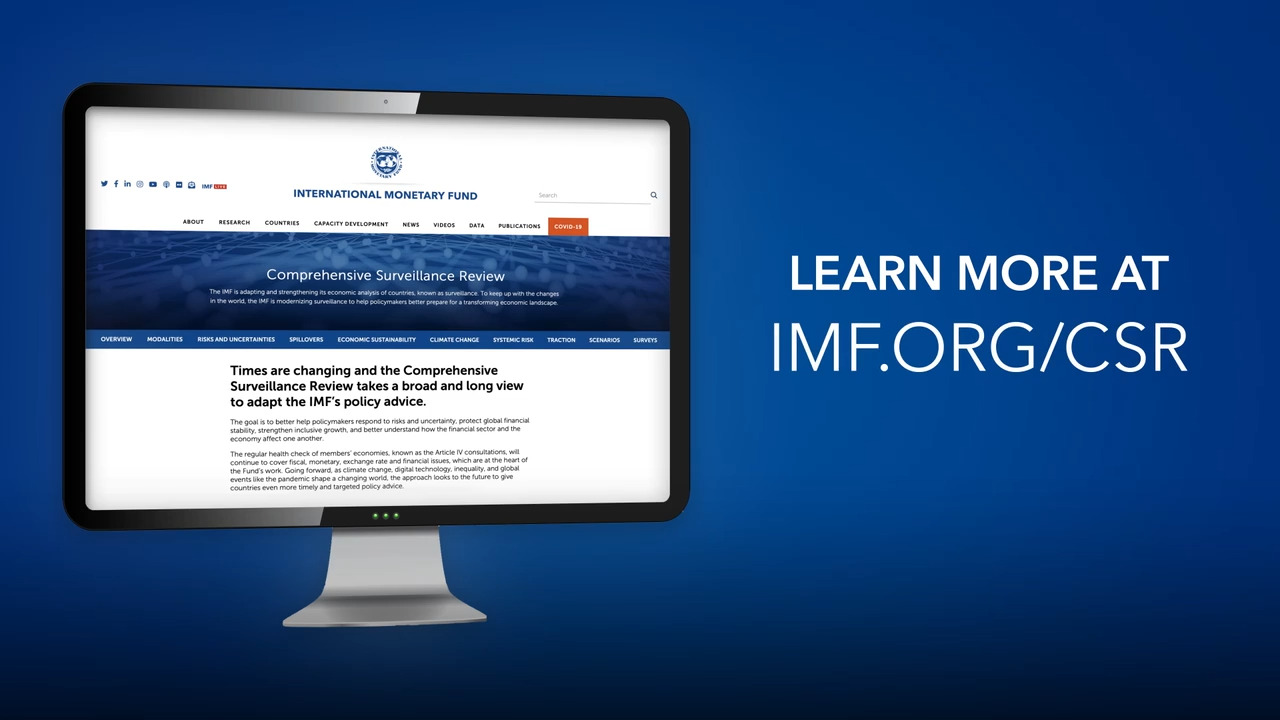
The IMF is adapting and strengthening its economic analysis of countries, known as surveillance. To keep up with the changes in the world, the IMF is modernizing surveillance to help policymakers better prepare for a transforming economic landscape.
Times are changing and the Comprehensive Surveillance Review takes a broad and long view to adapt the IMF’s policy advice.
The goal is to better help policymakers respond to risks and uncertainty, protect global financial stability, strengthen inclusive growth, and better understand how the financial sector and the economy affect one another.
The regular health check of members’ economies, known as the Article IV consultations, will continue to cover fiscal, monetary, exchange rate and financial issues, which are at the heart of the Fund’s work. Going forward, as climate change, digital technology, inequality, and global events like the pandemic shape a changing world, the approach looks to the future to give countries even more timely and targeted policy advice.
The review comprises ten policy papers that you will find below.
Fund surveillance needs to evolve to face the economic and financial challenges that will shape the global landscape for years to come. This paper takes stock of the current economic and financial landscape and sets out four priorities.
Modern surveillance needs to be more targeted, topical and timely, better interconnected, and better informed. The new surveillance modalities will help tailor policy advice, strengthen peer-learning, and better integrate macrofinancial analysis, supported by more and better data and tools. Implementation of the new modalities will be characterized by experimentation and learning-by-doing.
The coverage of risks has become more systematic since the global financial crisis: staff reports now regularly identify major risks and provide an assessment of their likelihood and economic impact, summarized in Risk Assessment Matrices. This paper outlines two areas for progress: an increased emphasis on the range of potential outcomes, to improve policy design, and more proactive policy advice on how to manage risks.
The IMF has a range of modalities and tools to cover spillovers. However, there remains scope to enhance synergies between global and country-specific spillover coverage and to foster cross-country dialogue. This paper shows that filling these remaining gaps in the Fund’s spillover work would allow for a more coordinated and evenhanded surveillance of spillovers.
Ensuring economic sustainability is key to achieve the IMF’s surveillance mandate to maintain present and prospective balance of payments and domestic stability, assure orderly exchange arrangements, and promote a stable system of exchange rates. This paper examines how a good understanding of issues related to economic sustainability is essential for the IMF to provide effective surveillance and policy advice, while it requires a broad perspective and a long time horizon. At the same time, given the wide range of issues that are related to economic sustainability, IMF surveillance needs to be selective and focused, with the choice of issues made on a case-by-case basis, considering country circumstances.
While the IMF has been involved in the climate debate since at least 2008, a systematic account of how to integrate climate change into surveillance has been lacking to date. This paper seeks to fill the gap and proposes a pragmatic approach that focusses especially on the mitigation efforts of the 20 largest emitters of greenhouse gases.
This paper assesses progress made in deepening and integrating systemic risk analysis and macroprudential policy advice in Article IV consultations following up on the findings of the Independent Evaluation Office evaluation.
This paper presents traction as a multidimensional concept and discusses a comprehensive and complementary set of approaches to attempt to measure it based on the Fund’s value added to policy dialogue and formulation and public debate in member countries.
The scenario planning exercises in this paper help to draw out the surveillance priorities and stress test the robustness of those priorities to uncertainties in the decade ahead. For example, to inform the two priorities on confronting risks and uncertainties and mitigating spillovers, the scenarios illustrate how different shocks and alternative policy approaches carry their own risks and can have both positive and negative spillovers.
This paper presents key results from the surveys of country authorities, IMF Executive Directors, and mission chiefs to inform the Comprehensive Surveillance Review. Key takeaways and cross-cutting themes that emerge are Trends, Policy Challenges, Surveillance Priorities, Surveillance Modalities, and Traction.

The IMF is responding to the policy challenges of a fast-changing global economy still reeling from the COVID-19 crisis: it is modernizing the way it provides its regular policy advice to member countries—a process known as surveillance.
June 23, 2022
This Guidance Note provides guidance to country teams for surveillance under Article IV consultations. It supersedes the 2015 Guidance Note and its supplement. Fund surveillance continuously adapts to the evolving economic and financial landscape. The 2021 Comprehensive Surveillance Review (CSR) identified priorities for Fund surveillance, both in terms of content and modalities.
February 8, 2021
This note provides updated guidance to country teams on bilateral surveillance in the context of Article IV consultations in light of the COVID crisis. This guidance impacts the focus, format and presentation of staff reports while keeping intact the substance of all existing Board-endorsed requirements.
April 17, 2018
Fund surveillance has become better adapted to the global conjuncture, and more integrated and risk-based. The recommendations of the 2014 Triennial Surveillance Review (TSR) focused on helping members navigate the post crisis challenges. Bilateral and multilateral surveillance discussions are underpinned by a shared and deeper understanding of global interconnectedness and linkages across sectors.